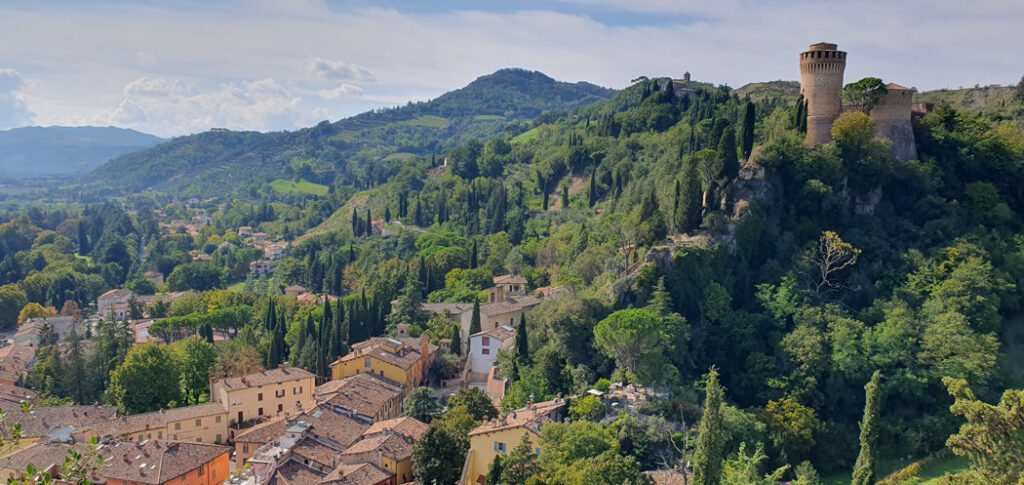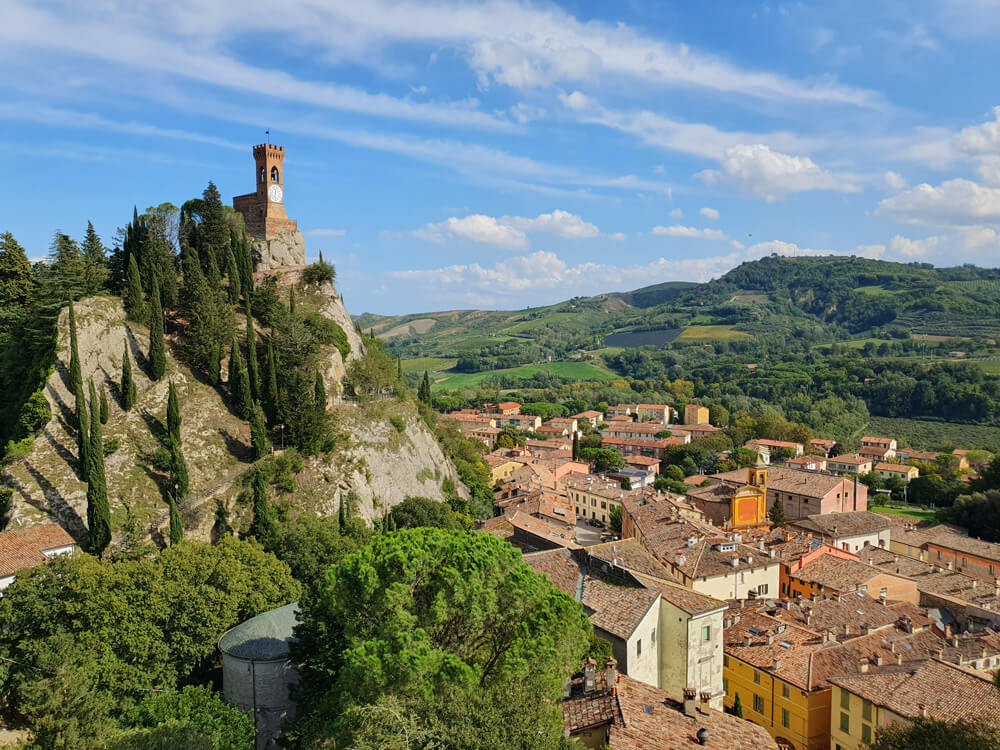Brisighella is a beautiful little hill town in the northern Italian region of Emilia-Romagna. Before I visited I’d heard claims that this is one of the finest small towns in Italy, and after enjoying a few sunny hours here I’d agree. I’ve visited a lot of Italy’s most beautiful places and I would rate Brisighella high among them; I found it enchanting. Yet it’s not really on the radar for mass or international tourism, making it extra enjoyable to visit.
With picturesque lanes, historic buildings, gorgeous views, and a village feel, Brisighella is a destination which oozes charm. The scenery that really sets this Italian heaven apart is its position beneath three pointed hilltops, each crowned with a building: a castle, a clock tower and a church. Climbing these viewpoints is a great way to work off a leisurely lunch feasting on some Brisighella’s food specialities.
Why to visit Brisighella
- Small-town Italy at its finest
- Ideal for a slow-paced day out
- Great destination for a long, lazy lunch
- Accessible for car-free travellers
- Exquisite hilltop views
- Italy as you’ve probably dreamt it
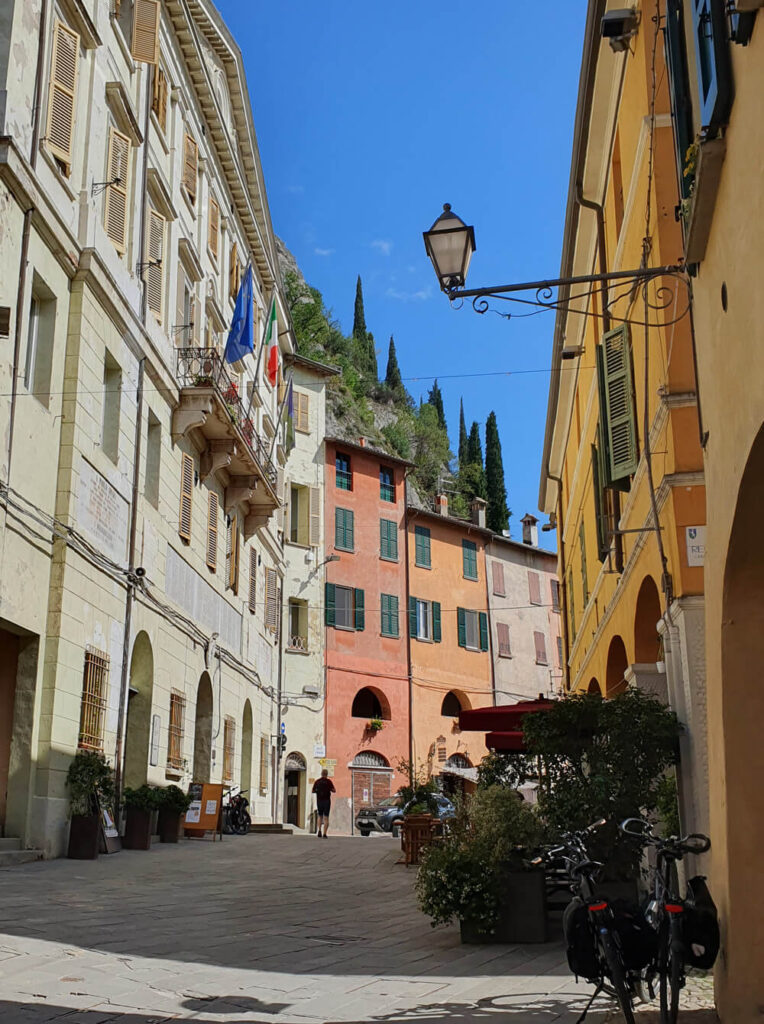
When to visit Brisighella
Brisighella is a good destination to visit all year round. However, what day of the week you visit will make a difference to your experience. The opening times of Brisighella’s ticket-paying attractions are limited and seasonal. If you want to enter the castle and one or two other sights during your stay, you will probably need to time your visit for the weekend, and bear in mind lunchtime closures. Generally the sights are open on public holidays (including Sundays) and the day before a public holiday. The town’s official tourist information website is the best authority to consult for up-to-date opening times, as well as local events, and the tourist office in town is extremely helpful too: https://www.brisighella.org/en/.
Although the town is geared up for weekend trippers, it is still a delight to tour on other days of the week. I visited midweek in September and spent an idyllic few hours here. The main attractions here, scenery, atmosphere and food, can all be enjoyed any day of the week. There were only a handful of other tourists in town (I saw about about twelve in total, mostly at lunch) and Brisighella had a lovely peaceful charm. I was sorry not to be able to time my visit to include the castle interior, as I do love both museums and castles, but I still felt the town was a more than worthwhile destination.
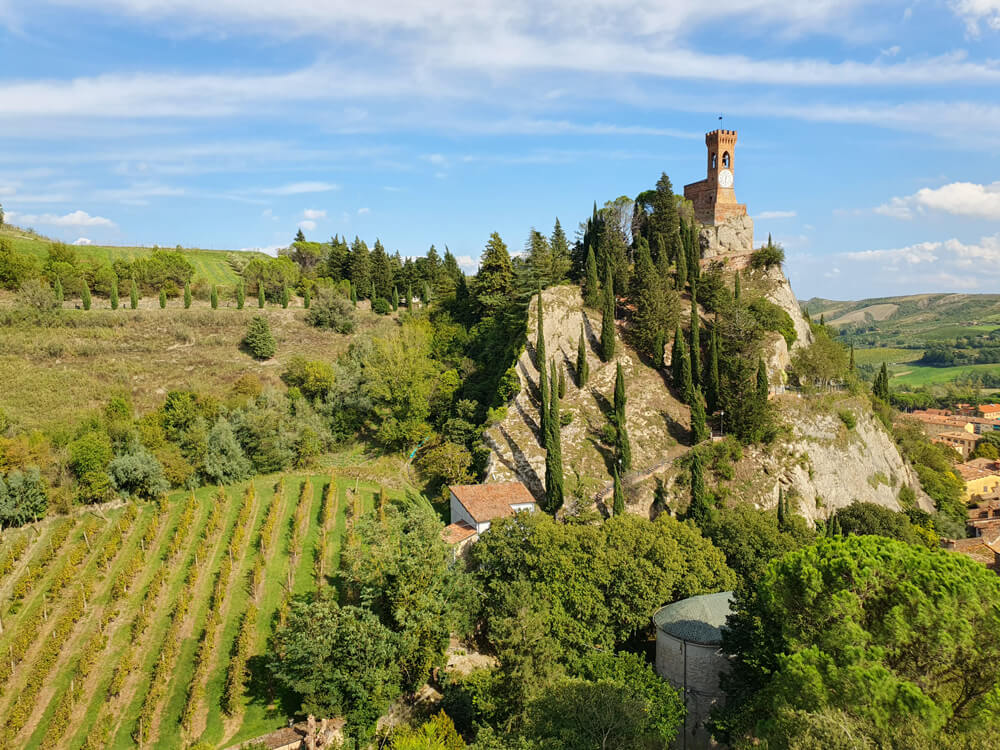
Getting to Brisighella
Brisighella is situated in the low green foothills of the Apennines in the region of Emilia-Romagna, not far from the border with Tuscany. It lies in the province of Ravenna. The closest large town to Brisighella is Faenza, famous for its ceramics, just seven miles away. While it has a lovely countryside setting, Brisighella is also decently connected by public transport, with a railway station and a bus connection. I’ve added detailed travel information for car-free travellers at the foot of this page.
Drivers will find a car park by the station and a few more parking places around town. The station car park is right next to the SP302, a road connecting Faenza with Florence. Brisighella is a good, straightforward day-out destination, whether you’re staying in Faenza or further away.
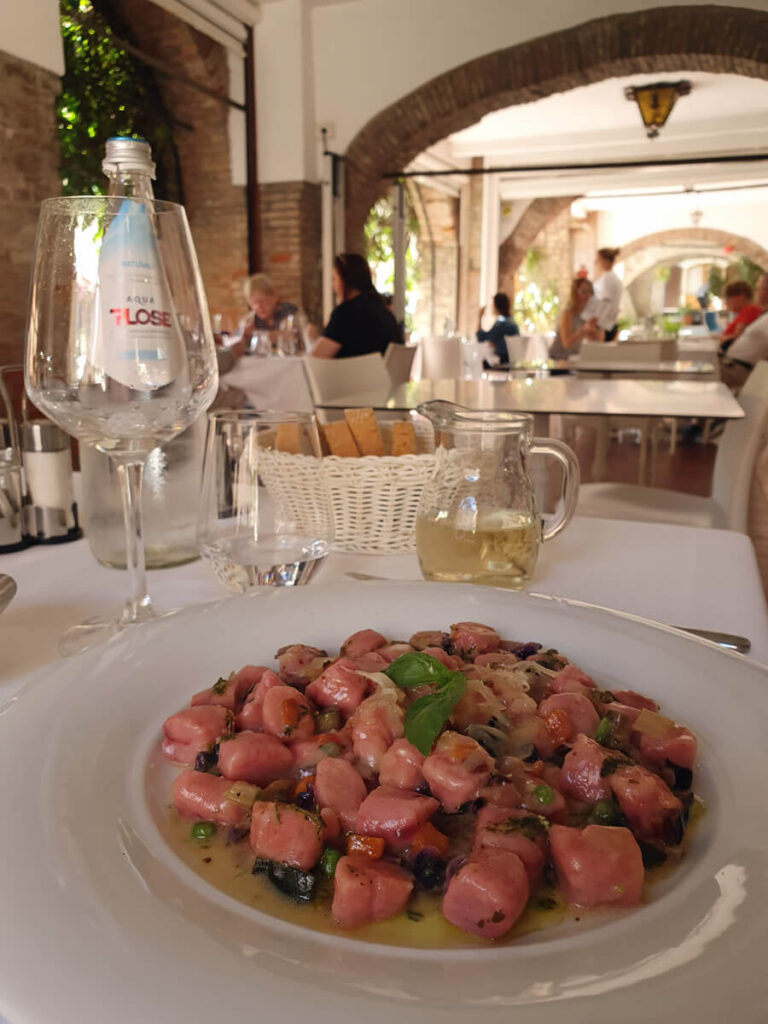
Where to stay in Brisighella
Brisighella is small and you can see it in a few hours. However, it would be a wonderful place to stay for a night or longer, soaking up the relaxed and civilised atmosphere and sampling its restaurants. There are some excellent places to stay, adding to the potential magic of your holiday. My top choice would be Albergo La Rocca, mainly because I ate an excellent lunch there. The hotel is very central and has a little roof terrace with the best views in town. But there are also tempting rural and B&B options.
- Find accommodation in and around Brisighella – or try
- Albergo La Rocca: comfort in the heart of town
- Casa Maghinardo: on the central piazza, an excellent B&B with a terrace
- Azienda Agricola Baccagnano – a rural stay just outside Brisighella, with an outdoor pool among vineyards
- Agriturismo Torre del Marino – restaurant-farm stay with views among the hills a short drive from town
Accommodation links on this website are affiliate links: if you make bookings through these you will be supporting this website without paying any extra. If you’ve found my destination guides helpful, please consider using or bookmarking my affiliate links, or buying me a coffee to help keep this website online. Thank you.
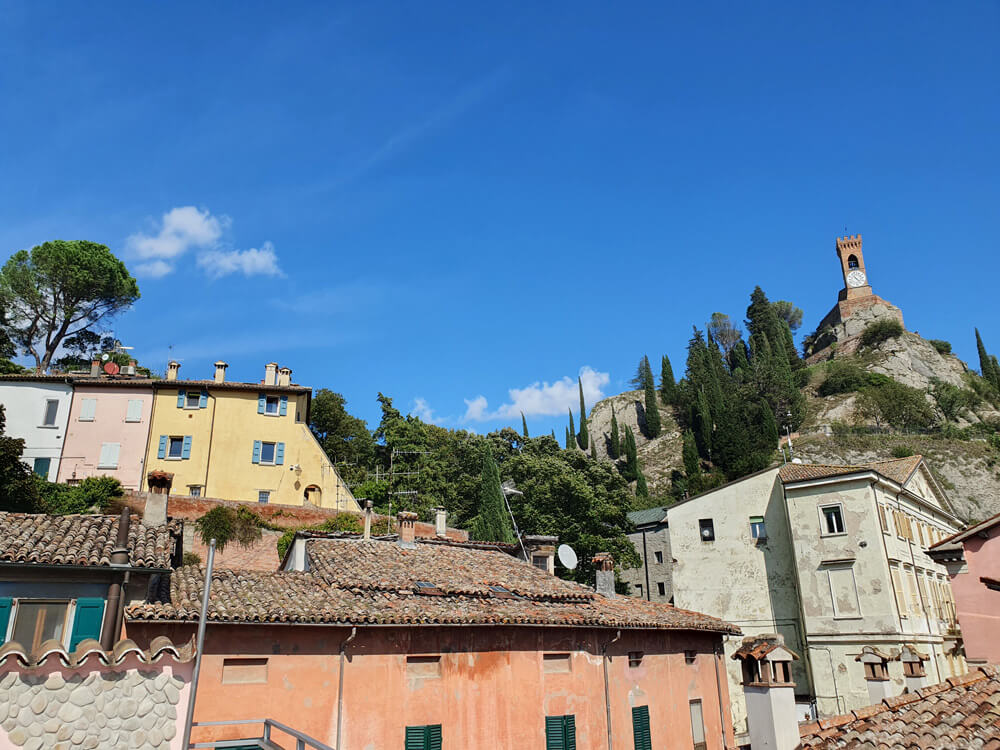
Things to do in Brisighella
Brisighella is best enjoyed as a leisurely exploration punctuated by fine food and drink. Although I call Brisighella a town based on its population, the central lanes are few and the atmosphere is very much that of a prosperous village. Some of the picturesque streets and angles were so unspoilt that I felt as though I was walking through the set for a period film.
A good way to begin your tour is with a stroll up from the railway station/bus stop/car park into the town’s central square, Piazza Carducci, a hub where several streets meet. On your right is the parish church, dedicated to St Michael. The church houses artworks including an altarpiece by Renaissance artist Marco Palmezzano from Forlì.
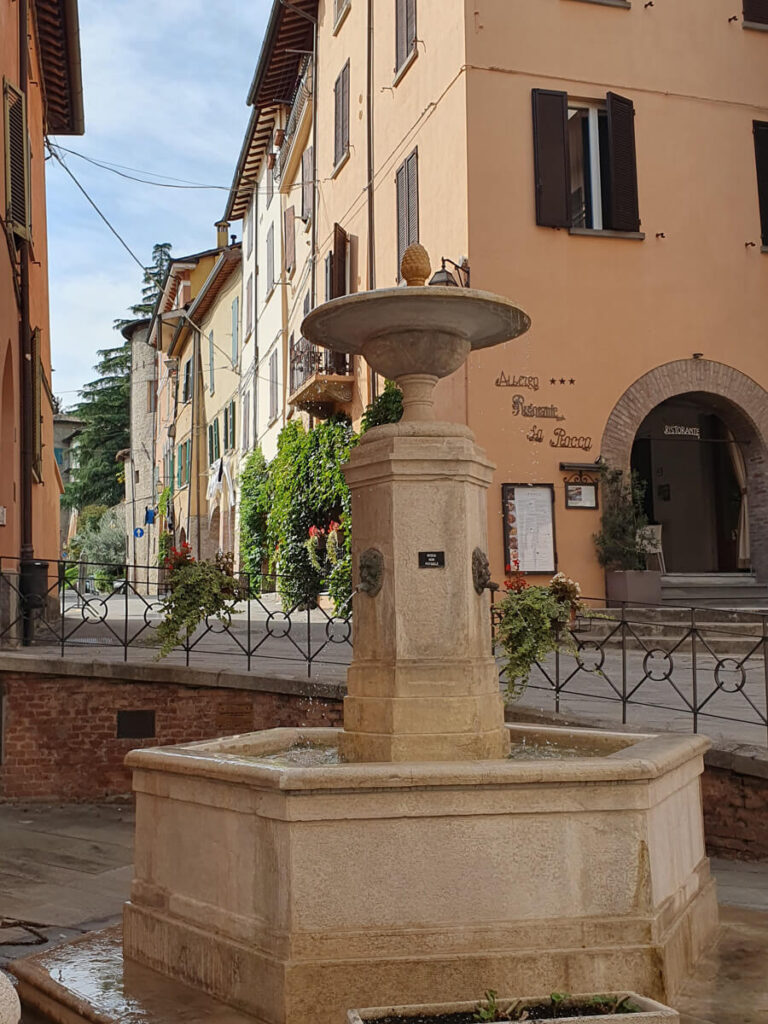
Continuing up Via Porta Fiorentina, you can admire the warm-hued painted buildings and views of the little hilltops above the town. At the top of the street, turn right onto Via Naldi. I’d suggest popping into the welcoming tourist information office (at Via Naldi, 2) at this point to pick up maps, advice, opening times or any other information that might help you get the most from your time in the area.
Via Naldi opens onto the long Piazza Marconi, with the imposing town hall at one end and a glimpse of Brisighella’s hilltop fortress above. The greatest sight here, though, is a secret hidden in the tall painted buildings on your left.
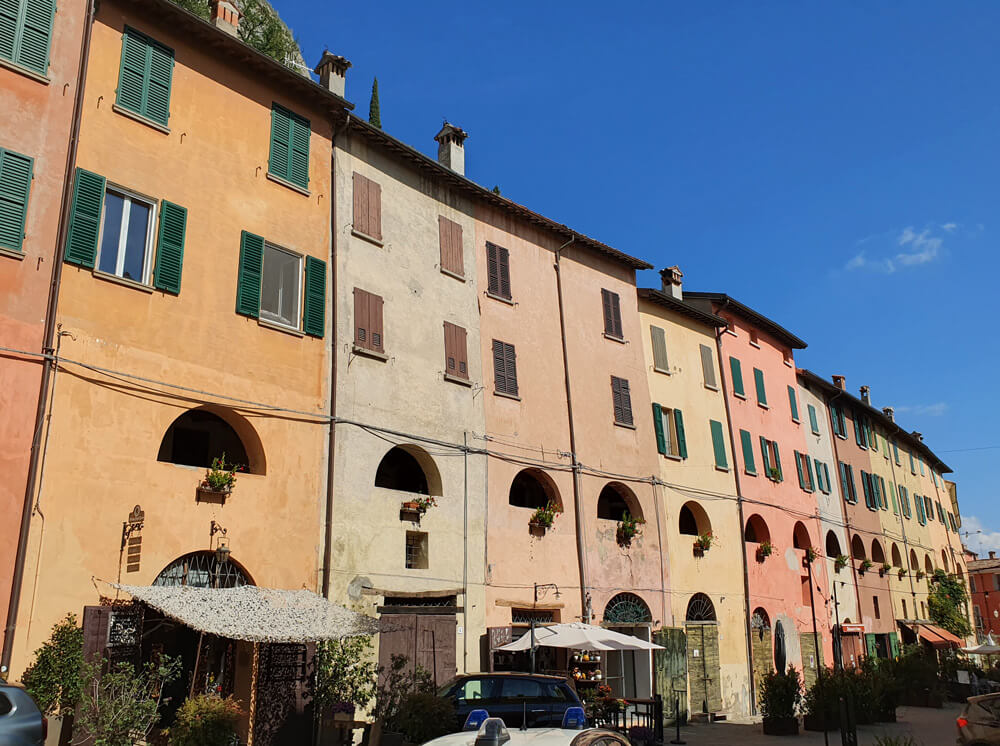
While Brisighella is both charming and characteristic, it has one particular sight that is unique in Italy. The Antica Via del Borgo, or Via degli Asini (Donkeys’ Way), is a covered paved walkway running through the buildings above street level. Illuminated through a series of low arches, this elevated and protected route dates back to around the fourteenth century.
Before it was covered, the path was once part of the citadel’s defences. Later, enclosed and with houses built above and around, it became a route used by donkeys and mules carrying precious loads of local products like gypsum from the quarries nearby. Stables opened off the passageway, and families lived on the floors above.
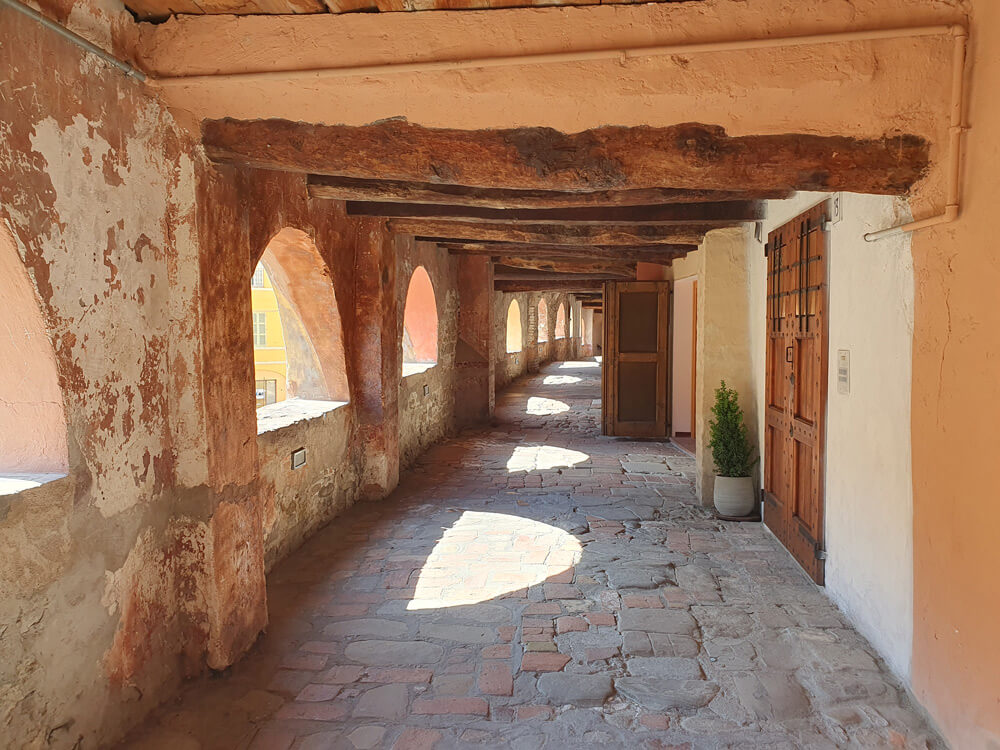
This fabulously atmospheric space can be reached by flights of steps up from the street at each end. Once you’ve walked the length of the passageway, return to the stairs nearest to the town hall. Here you can continue uphill and find the route leading up to the clock tower above town. This is the starting point for a super, up-and-down walk (around 40 minutes) visiting two of the pinnacles above town. This scenic walk has some spectacular viewpoints – but be prepared for short but energetic climbs up and down steps and pathways at the beginning and the end (I suggest alternative access by car below).
The Torre dell’Orologio and footpath below the summit offer some of the best views of Brisighella. Standing on the site of an earlier defensive watchtower, the clock tower was built in 1850. As you enjoy this short panoramic walk you’ll probably hear the six-hour clock striking each quarter hour. The tower is open to the public with a similar timetable to the town’s other sights.
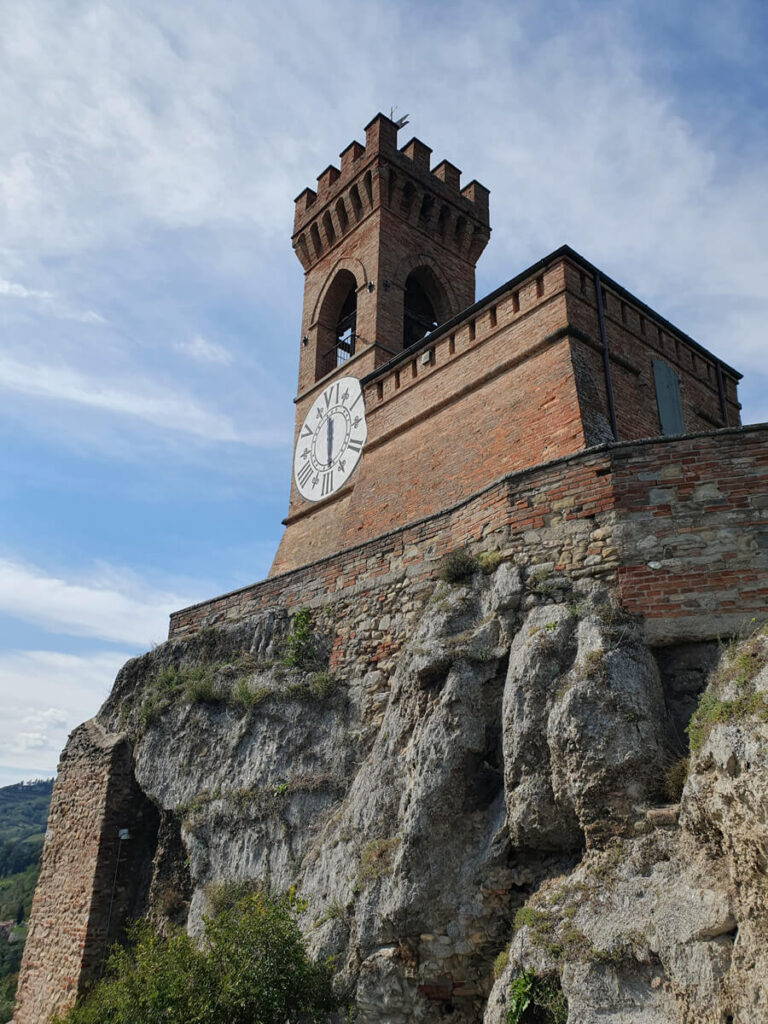
From the Torre dell’Orologio there is a very picturesque farm track winding around the slopes behind, looping around the head of a valley and then leading to the castle on the rocky summit opposite. As well as ensuring conveniently that you don’t have to lose or gain much height on this part of the walk, it is also an enjoyable chance to feel part of the countryside and appreciate the low rolling green hills of this part of Emilia-Romagna. There’s even a chance for vineyard photos.
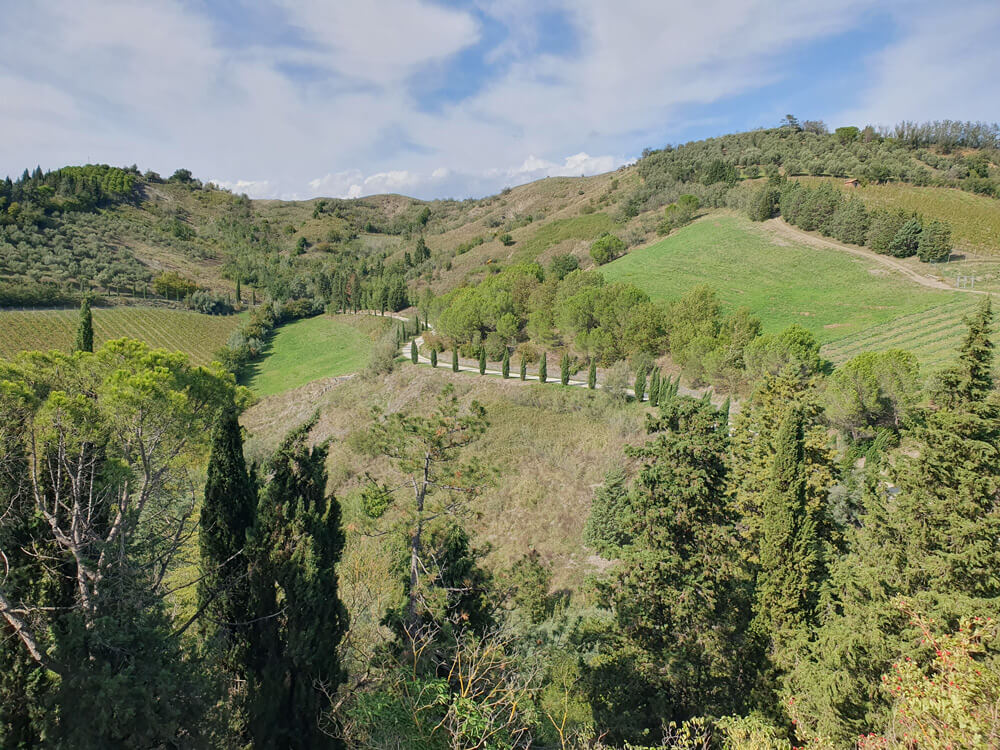
Brisighella’s castle, the Rocca Manfrediana e Veneziana, is a squat fortress with a tall round tower dominating the skyline. Dating back to the fourteenth century, the castle was built by the local Manfredi lords and later added to by the Venetian Republic. It has been restored and now houses museum displays covering the relationship between man and chalk, the medieval and Renaissance eras, and local archaeological discoveries. As it was closed, I could only admire from the outside, but it definitely sounds worth including in your itinerary if open.
Driving and/or not feeling energetic? There is a road, Viale Pascoli, winding up to a small parking area close to the castle walls. If you’ve arrived with a car and prefer to avoid the steps between the hills and the town centre, you could park here to visit the castle and then walk around the track leading to the Torre dell’Orologio.
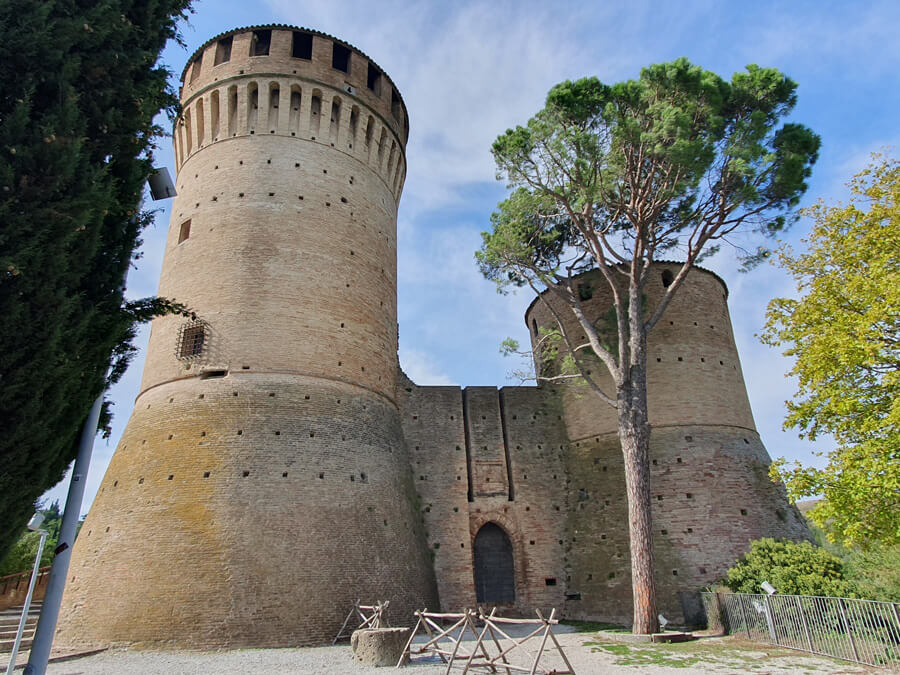
From the Rocca several routes of steep paths and staircases descend to the town centre, offering more views over Brisighella’s rooftops, and the occasional bench on the way.
If you’re feeling energetic enough to tackle Brisighella’s third hilltop, the route leads up a lane branching off the road uphill from the Rocca. This was closed when I visited due to a landslip: check locally when you visit. On top of this hill is a church, the Santuario della Madonna del Monticino. Below it, and signposted from the access lane, is an open-air geological museum in a historic quarry. This incorporates information panels and an educational trail; another attraction I was sorry to miss.
Other sights in Brisighella include the sixteenth-century church of Santa Maria degli Angeli, which has another altarpiece by Marco Palmezzano, and the convent alongside. There is a town museum, the Museo Civico G. Ugonia, included in the admission ticket for the Rocca. This contains works by local artist Giuseppe Ugonia (1881-1944).
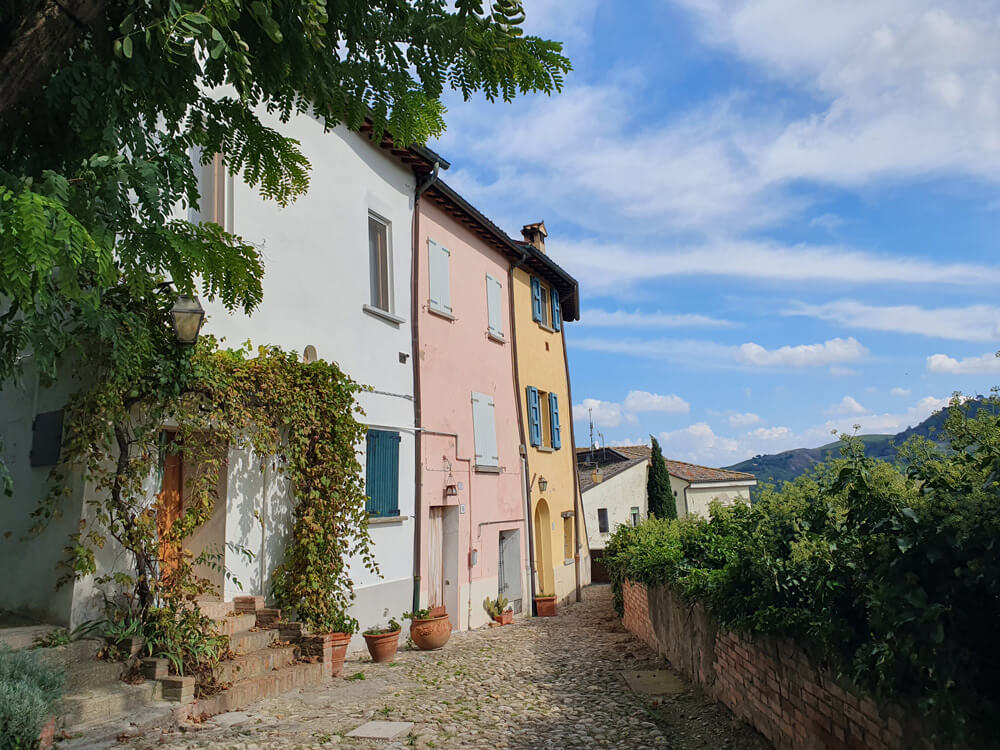
Around Brisighella
In walking distance of the town, though with very limited opening hours, is a fine Romanesque church, the Pieve di San Giovanni in Ottavo (or Pieve del Tho). Built somewhere between the eighth and tenth centuries, this is on an older site and there are Roman finds on display too, as well as re-used Roman architectural elements and fourteenth-century frescoes. Sadly, at the time of writing the building is only open for a couple of hours on the afternoons of public holidays.
The outdoor geological museum described above lies at the edge of a regional park, the Parco Regionale della Vena del Gesso Romagnola. This includes sites in a UNESCO World Heritage Listing: Evaporitic Karst and Caves of Northern Apennines. If you have more time to explore the area, this makes an interesting destination to discover. You’ll find a visitor centre (and food) at the Rifugio Cà Carnè, a short walk or a hike from Brisighella. There are visitable caves including the Grotta della Tanaccia, near the visitor centre: tours are with a speleologist and should be booked in advance through the visitor centre.
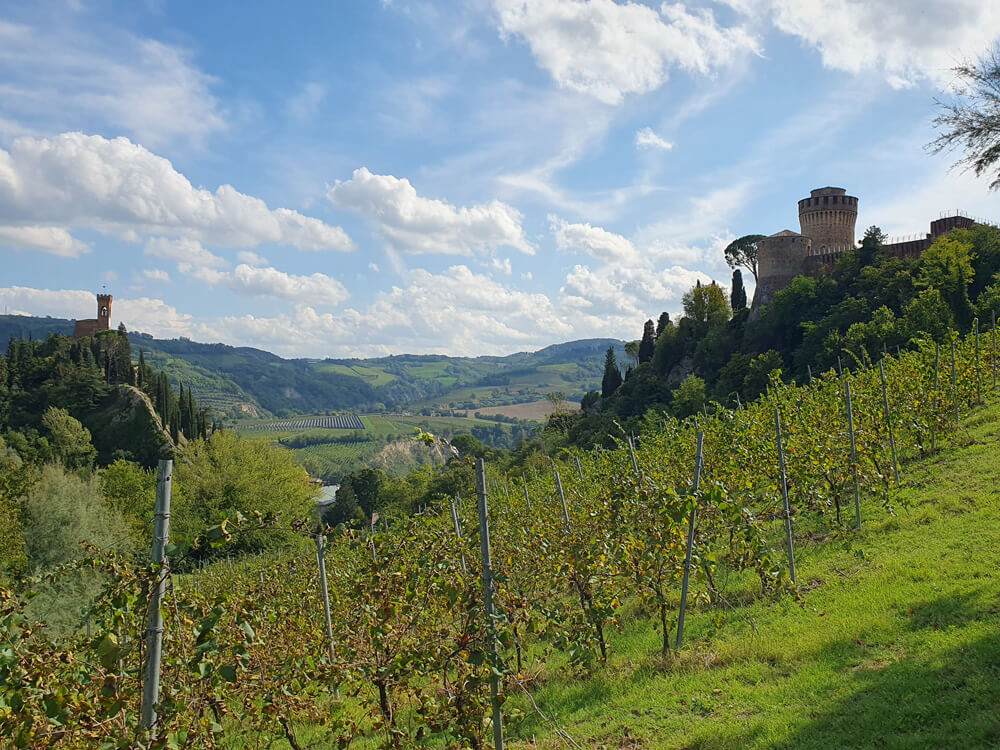
Around Brisighella and in the regional park there are various hiking routes and trails which enable you to see more of this attractive landscape. One of these is the Sentiero dell’Olio (Olive Oil Path), starting at the railway station, passing the Pieve del Tho, and winding through olive groves where the famous local olive oil is produced. There’s an information board about this circuit on the street near the station.
Eating and drinking
High on anyone’s list of priorities in this part of Italy should be food and drink. Emilia-Romagna is a famously foodie region of Italy, and Brisighella is a renowned foodie destination within Emilia-Romagna. So you will find plenty of delicious food and local wine to enjoy, including Romagnola regional specialties. There’s a tempting choice of restaurants, some with outdoor tables and one in a cave (La Grotta, below the Via degli Asini). I had a delicious and good-value three-course lunch with a little jug of house Prosecco at Albergo La Rocca, in a covered outdoor terrace under an arcade.
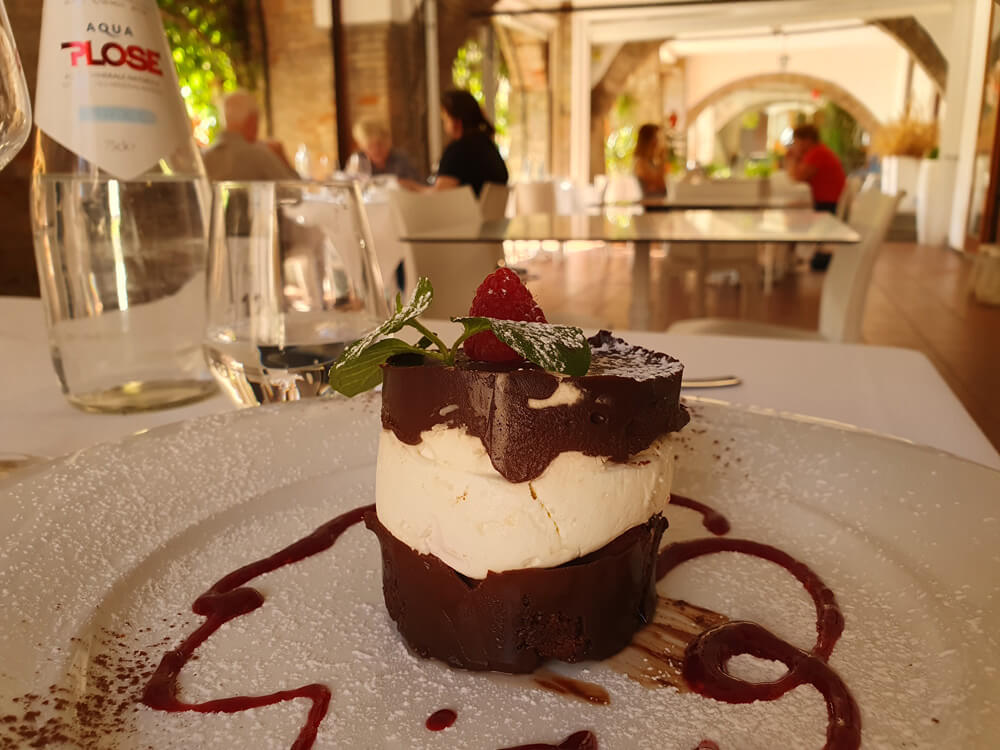
Brisighella’s most prestigious culinary export is its green extra-virgin olive oil, its special qualities a product of the local microclimate. Another prized product is the Moretto artichoke (Slow Food catalogue entry). ‘Forgotten fruits’ including a type of pear are also grown and celebrated locally. Cheeses from the area include the soft cheese Lo Stanco made from raw milk, and cheeses matured in local chalk caves. Wines produced locally include the red Sangiovese DOC and white Trebbiano.
Brisighella and fast cars
It could have been the photo of champion Max Verstappen in the hotel where I ate lunch that tipped me off. But actually I already knew about this tiny town’s Formula 1 connections.
Trofeo Bandini
Awarded each year to a leading figure of Formula 1, the Trofeo Bandini is an award which commemorates the racing driver Lorenzo Bandini, who died after an accident in the 1967 Monaco Grand Prix. Bandini’s father was from Brisighella and he spent part of his childhood here. The trophy is usually presented in Brisighella, generally timed to tie in with the Emilia-Romagna Grand Prix in nearby Imola. If you’re visiting around this time or attending the Emilia-Romagna GP this presentation is worth looking out for – to see, for example, scenes like George Russell driving a vintage car through the picturesque countryside from Faenza to Brisighella (the video includes the presentation in the Rocca and an interview filmed on the roof terrace of Albergo La Rocca).
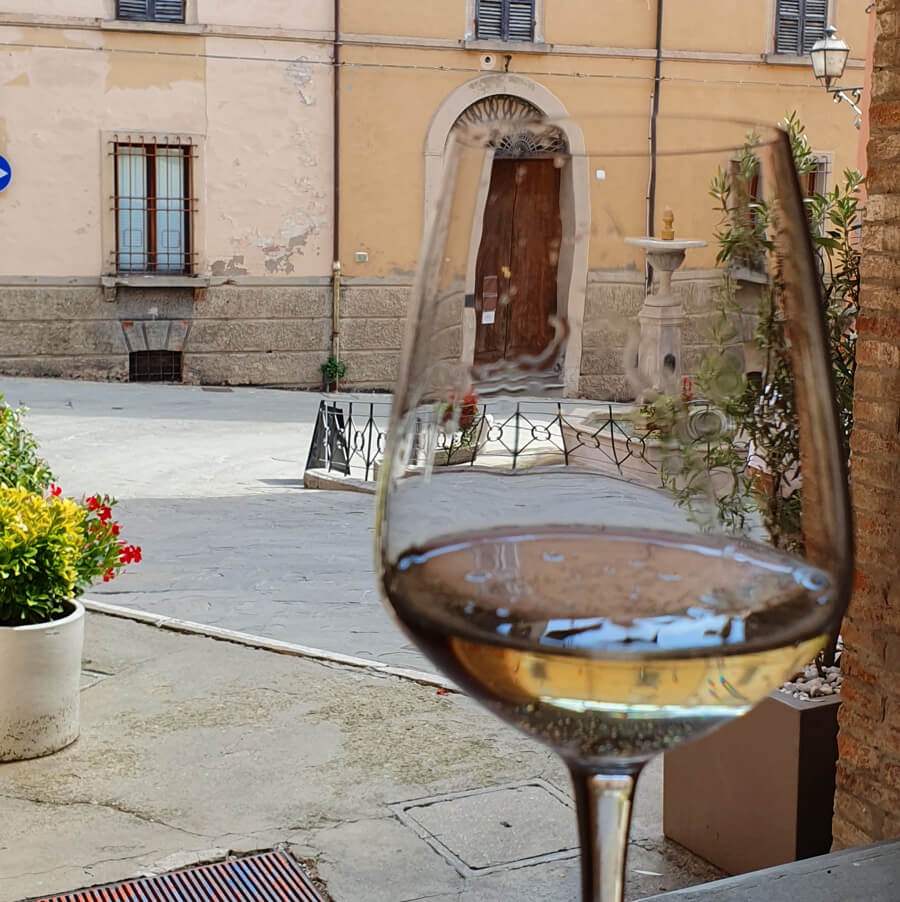
Events
Brisighella and its excellent tourist office put on a lot of events throughout the year to entertain and entice visitors. These include medieval costumed fairs, a ‘Romantic Brisighella’ event, a weekend walking festival and various food festivals (sagre) celebrating local products including artichokes, polenta, pork, pears, cheese and the town’s famous olive oil. Check out the tourist information website for a calendar (you may find the Italian-language page more up-to-date than the English translation): Brisighella events.
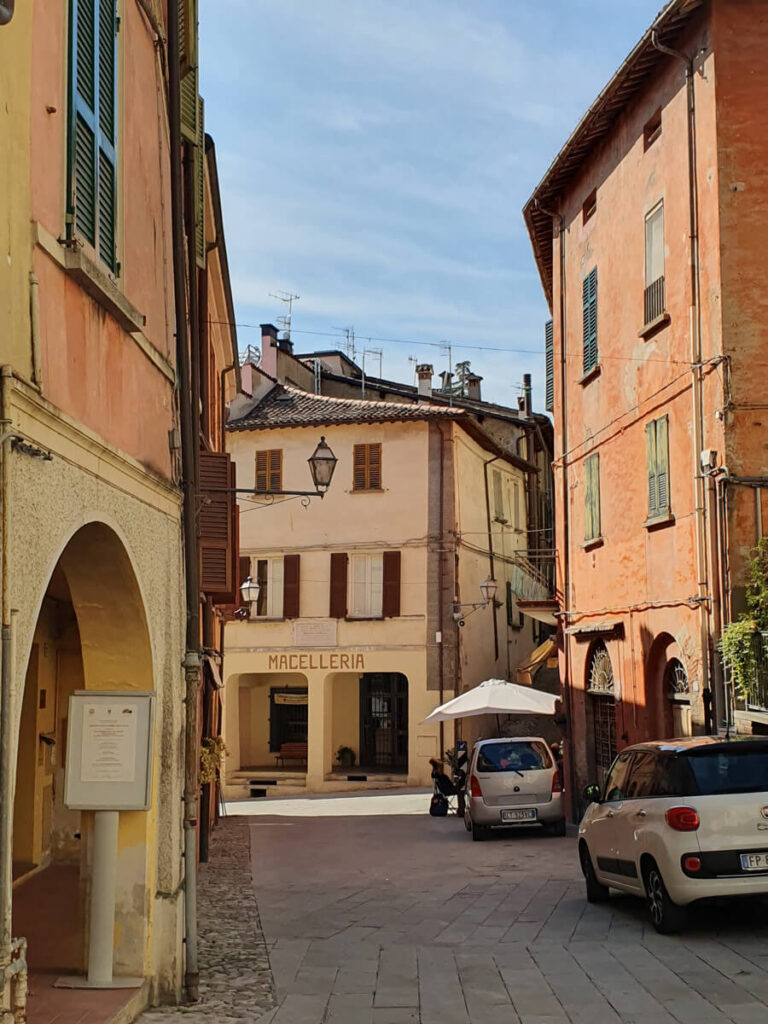
Brisighella by train and bus
Brisighella has a railway station just a few minutes’ walk from the heart of town. This station is on a historic, scenic railway line between Faenza and Florence, called the Ferrovia Faentina. Brisighella is around ten minutes by train from Faenza (when I visited, a stretch of this line had been damaged by floods, but there were rail replacement buses). The station is small with minimal facilities, though it does have a ticket machine. Tickets can also be purchased at the bar just outside.
A bus service, the 199, also connects Faenza with Brisighella, a journey of around twenty-five minutes. In Faenza buses depart from the bus station (Autostazione), which is next to a bar on Viale delle Ceramiche. There are also a few stops en route through Faenza, including one closer to the railway station, on Viale IV Novembre. When I visited this bus service was operated by Coop Trasporti Riolo Terme, though its timetable was also listed in the Start Romagna timetable (Ravenna section); Start Romagna travelcards were not valid, however. At the time of writing tickets can be purchased onboard from the driver. There are two convenient bus stops in Brisighella, one stop before the railway station and one just afterwards; either of these is handy for the centre, which is just a few minutes uphill.
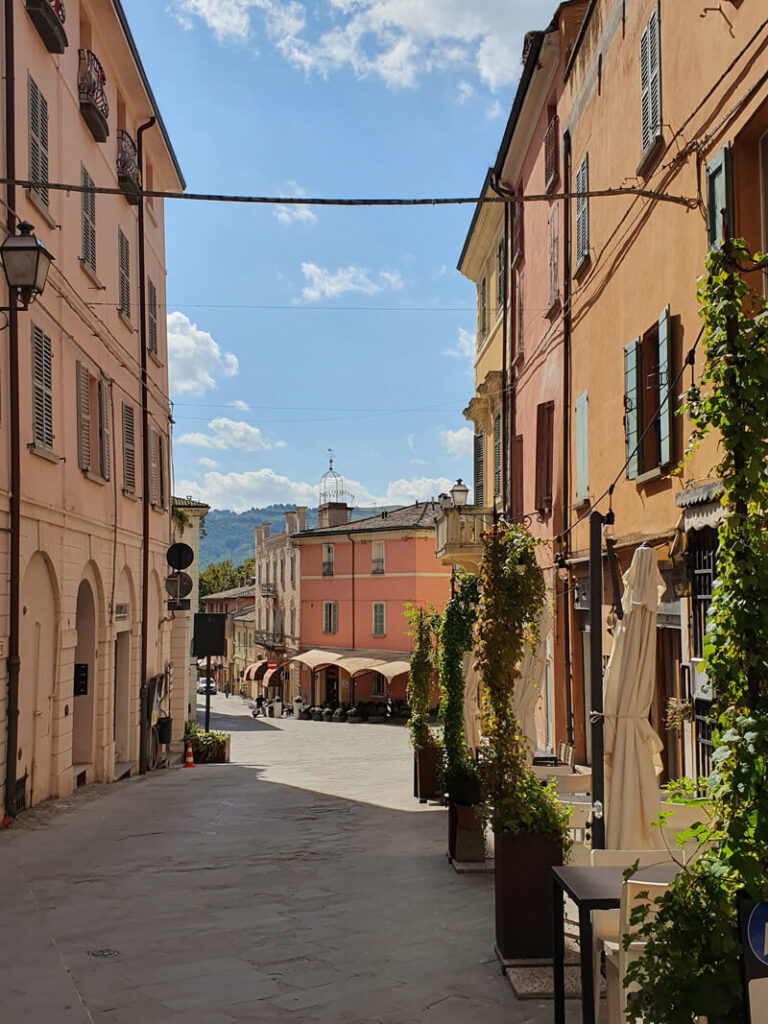
From the railway station you can reach the centre by walking up to Via Roma and turning right, or by heading through the little park opposite, past Wednesday morning food market stalls and turning left uphill. It’s a pleasant and short stroll.
If you’re visiting Brisighella by public transport you do need to plan your day in consultation with timetables – there can be some longish gaps between trains or buses and it may work out best to take one mode of transport in one direction and the other for your return – but it’s entirely do-able.
From further afield, most routes will involve changing in Faenza. Faenza is on the main railway line between Bologna and Rimini, and is easy to reach from all the towns along this line including Imola. I travelled from Rimini on my research trip, and saw both Faenza and Brisighella in a day, lunching in Brisighella. Ideally Brisighella deserves longer than half a day, though – especially if you are visiting when the sights are open and you fancy a country walk and a leisurely meal.
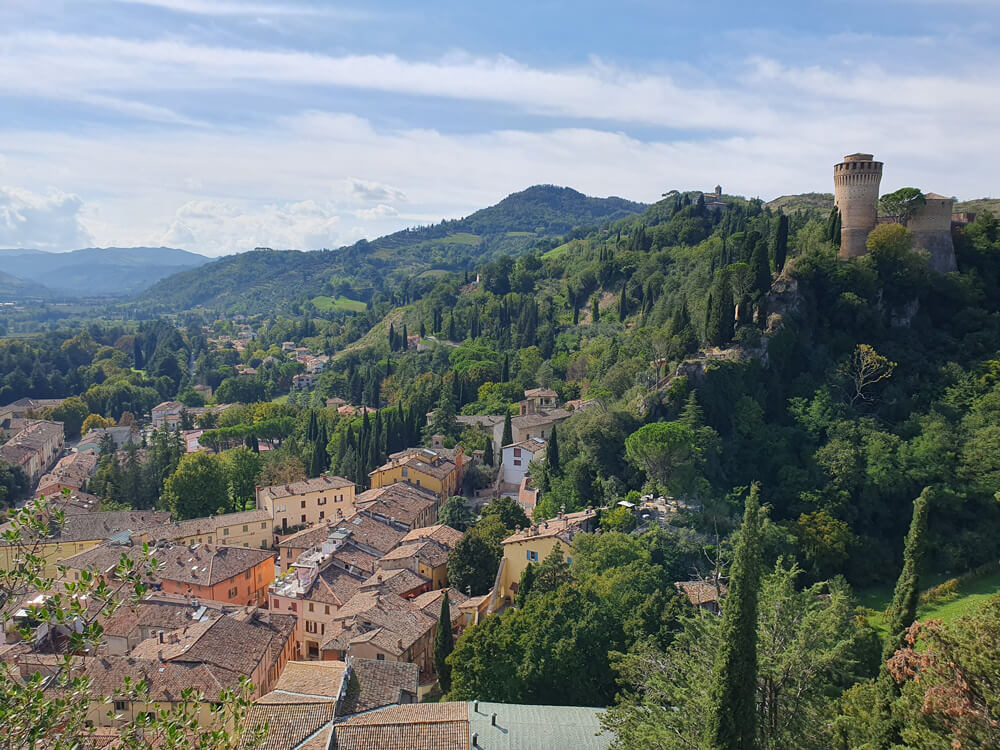
Emilia-Romagna destinations
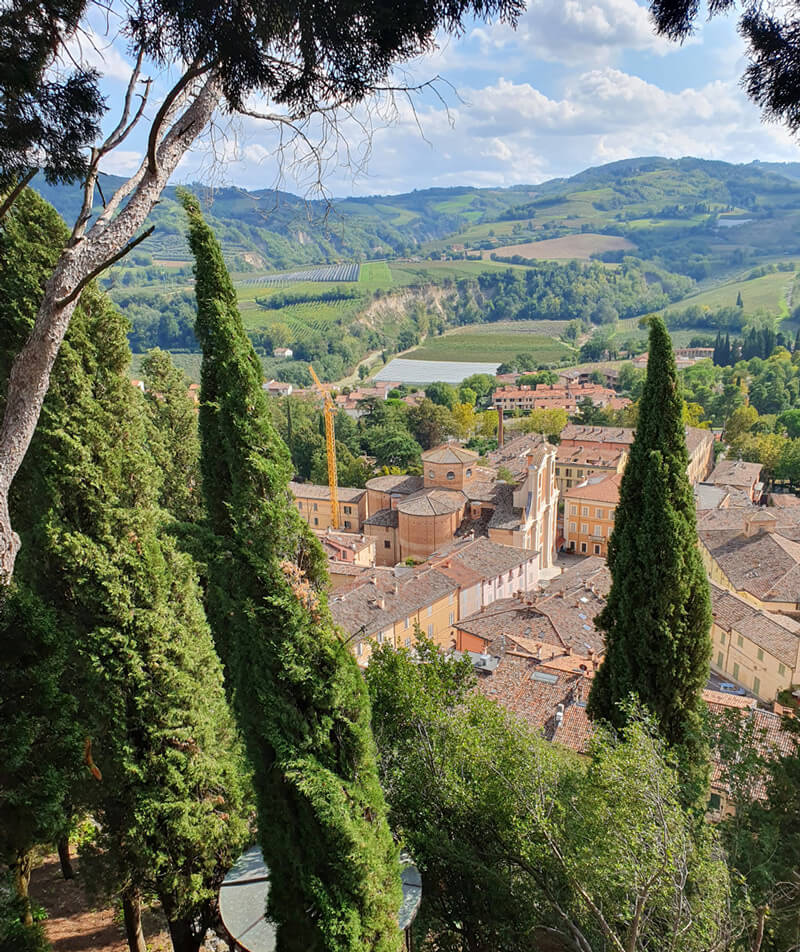
If you like Brisighella
You’ll also appreciate lovely Asolo, in the Veneto near Treviso. Brisighella reminded me of Asolo; a pretty historic town in sweet green foothills ideal for a civilised weekend enjoying la dolce vita.
